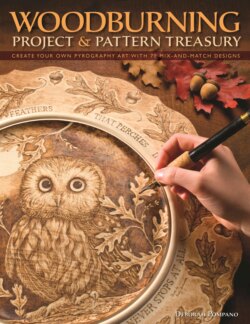Читать книгу Woodburning Project & Pattern Treasury - Debbie Pompano - Страница 10
На сайте Литреса книга снята с продажи.
INTRODUCTION
ОглавлениеMore and more people are beginning to rediscover the deep satisfaction and peace that can be found in the creative arts.
As a teacher, I believe that woodburning is a craft that is accessible to everyone, and there is no need of formal art training. Happily, woodburning is an art form that requires minimal workspace and doesn’t create a big mess in your home. It is easy to learn, fun, and rewarding, and you will be amazed at how rapidly your abilities grow and improve with just a small investment of time, patience, and practice. Best of all, you don’t need to know how to draw to get started with this book! Woodburning is not an expensive craft either; a high-quality burner, a few tips, and wooden objects to woodburn can be obtained easily and at minimal cost.
I discovered woodburning at a craft show in 2002, when I saw a portrait of an Indian chief burned into a basswood plaque. I was immediately intrigued and fascinated by the sepia-toned, engraved-looking burned lines, contrasting with the warm, natural wood tones and grain of the wood. I had worked with many painting and drawing media, and done scrimshaw, but had never seen anything quite as unique and beautiful as this.
I have always loved to draw, and I immersed myself with sheer delight in the study of pyrography, experimenting with different woodburners, tips, types of wood, and staining and finishing techniques. I learned the primary importance of including fun and love in the preparation and completion of a woodburning, and I found that the pieces that satisfied me the most came from my heart. Of course, I also made mistakes as I was learning these new skills by trial and error, and you can reap the benefit of my struggles by learning some very easy ways to fix common mishaps. You will find that wood is actually a surprisingly forgiving medium.
This is a book for beginners, intermediates, and advanced woodburning enthusiasts. I show you how to find sources of inspiration and subject matter for pyrography, and I cover everything from basic burning tools, through how to transfer a pattern, easy burning and coloring techniques, shading and texturing techniques, and how to sand and finish your pieces. I have carefully designed the projects in this book for you, ranging from very basic to more advanced, so you can spend many quiet, peaceful hours experiencing the joy of pyrography while creating personalized gifts and unique accents for your home. You will be amazed at how even the simplest woodburned designs can create such subtle and rich effects!
Don’t be concerned if you think you don’t know how to draw. As you begin these projects, you can simply use the ready-made complete patterns provided for you, which can easily be transferred to the wood. As you become more confident, you can learn to create your own unique patterns that truly express your spirit by choosing individual design elements and combining them with the mix-and-match pattern section of the book. For example, you could begin with a central image, add a simple or more complex border to your design, and perhaps even add a poem or saying to personalize your work even more.
There are so many ways to use woodburning. A woodburned platter looks lovely as a wall hanging, and you can frame woodburnings done on birch panels. Woodturners can burn small vignettes and designs to accentuate their platters and bowls, using the grain of the wood as part of the design. Basket makers can use these designs on their woven baskets, and the patterns also work well for woodburning on gourds. Picture frames, mirror frames, box lids, chess or checker boards, wooden utensils, stepstools, and furniture can all be enhanced with woodburning designs. From the smallest keychain to a large, framed, woodburned wall hanging, the possibilities are limitless!
When exhibiting my work at craft shows, I have sometimes overheard a disconcerting comment from people looking at my woodburnings: “These are made by a laser—they aren’t handmade.” I suppose it is a sort of backhanded compliment to hear that my work looks that good! I can assure you that I have designed, hand-drawn, and hand-burned every line in these pieces and patterns, and now it gives me great fulfillment to share them with you. I hope they will provide you with many happy hours of creativity and results you can be proud of.
Well, enough talk! Let’s turn up the heat, and start creating some woodburnings!
VARIATIONS ON A PATTERN
To give you an idea of how differently artists will interpret a theme, even when using the same patterns, study the student work presented at right. Three different moods and interpretations were created using the same lighthouse pattern. One student decided to create a simple border, while the others used only the central image pattern. You can see how unique and individual the results can be. It may inspire you to know that two of the students were beginners and had not tried woodburning until this class!
Student lighthouse woodburnings from the 2009 John C. Campbell Folk School.
Ruth Elsner
Bob Maher
Frank Penta
